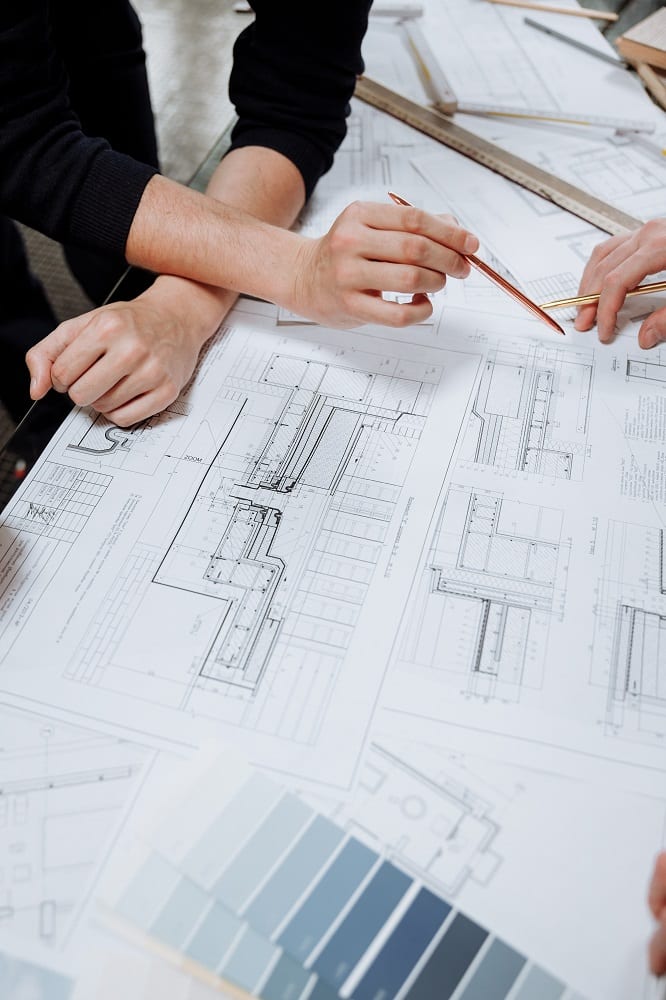Choosing the right career path can be an overwhelming and daunting task. So, it would help if you had a clear idea about the professional field.
The world of architecture is vast, and, as an architect, you’ll have the responsibility to create and change the elements of that world. But, before stepping into that world, it might be a good idea to do some research regarding what the job of architecture entails.
We are here to help you with that. In this article, we’ll go back to the very basics of architecture and talk about the origin and architecture. We’ll also try to guide you through the various aspects and traits that can make you a successful professional architect.
Once you are well aware of the functions of an architect, it’ll be easier for you to decide whether you want to venture into the world of architecture.
So, without any more jibber-jabber, let’s begin!
What Is An Architect?

An architect is a trained professional responsible for designing buildings and plays a major role in supervising the construction process. As an architect, you need to be highly trained in the science and art of building designs and construction.
Moreover, an architect is a person professionally engaged with maintaining the health and safety of the building occupants. So, to become a professional architect, you will need to have a legal license or proper authorization from the government.
Roles And Responsibilities Of An Architect
To put it into simple words, architects design buildings. However, their role in building design and construction is more holistic than anyone else. Their responsibilities transcend far beyond simple building design. They are responsible for managing their employees, along with securing new businesses.
Furthermore, an architect invents things that are not only creative but also sustainable. Architects work towards translating their ideas and schematic designs into reality.
Additionally, architects are required to communicate effectively with their clients to carry out complex projects successfully. A licensed architect is also responsible for protecting the health, safety, and well-being of future building occupants.
Moreover, the work of an architect must follow the budget limitations, client’s desires, building codes, government regulations, and many more practical concerns. Hence, architects need to supervise the overall building process starting from designing to site selection and construction.

Origin Of Architects
The word “architect” in English has its roots in the Greek “arkhitektõn,” which means “chief builder.” But, it actually originates from the Latin “architectus” that comes from the Greek “arkhitektõn” as well. If we consider the history of architecture, there was no difference between architects and builders earlier.
However, with the advancement in linear-perspective drawing, building designs came into existence. This development of linear-perspective drawing allowed the architects to represent three-dimensional structures accurately in two dimensions.
Hence, during the late 1500s, artisans started designing buildings extensively before their construction.
Furthermore, with the increasing availability of pencil and paper, building design became much more important before actually constructing the building. Thus, the roles and responsibilities of architects started to differ from that of the builders gradually.
Moreover, with the establishment of new organizations like the American Institute of Architects (AIA) and the Royal Institute of British Architects (RIBA) in the 1800s, professional architects started to promote their craft. Thus, over the years, they have developed and perfected their architectural profession to become chief building designers.
Different Types Of Architects
With the development of modern architecture, different types of architects have emerged over time. In this section, we’ll be discussing some of the most widely known architect jobs. So, let’s look into it!
1. Design Architect
As a design architect, you’ll have the responsibility to create the overall project design. So, traditionally, a design architect is a person who designs buildings as per the client’s needs. Moreover, design architects need to analyze the surrounding site environment, consider the client’s budget to create a building design that is feasible, and follow all these parameters.
2. Technical Architect
Any large-scale building project usually requires fine technical details that must be included in the overall design. This is where technical architects come in. They work to incorporate these fine technical details into the building planning to ensure that it is both feasible and functional. They also participate in producing technical drawings and supervise the construction administration.
3. Naval Architect
Naval architects are specialized in creating designs for building aircraft carriers to submarines, sailboats, and tankers. They are not responsible for creating commercial or residential building plans, unlike traditional architects.
As a naval architect, you’ll be responsible for building and maintaining warships and even heavyweight cargo ships. Thus, the job profile and responsibilities of a naval architect largely differ from that of any commercial architect.
4. Landscape Architect
Landscape architects create designs and plans for outdoor spaces like parks and gardens as well as the structures within them. Additionally, with the advancement in urban planning in the 21st Century, the roles of landscape architects have become more diverse than ever.
To design any park or garden attractively, they need to have abundant technical knowledge regarding stormwater management, planting design, and sustainability planning.
5. Interior Designer
In large constructions and building projects, interior designers play a crucial role in offering a comfortable and cozy living experience to the building occupants. They are responsible for furnishing the building interiors, such as arranging the non-bearing walls and doors, choosing furniture, placing power outlets, and so on. They are also responsible for decorating the interiors in a way that follows the building codes and satisfies the client’s needs.

Stages Of The Architecture Process
Before venturing into the world of architecture as a professional architect, you need some basic knowledge about the entire architecture process. The architecture process can be generally described in four stages, which we have highlighted here.
1. Schematic Design
To practice architecture means interacting with your clients to come up with a design that fulfills their needs. The initial stage of schematic designing helps to come up with a simple building design that is easily comprehensible to the clients.
Moreover, the schematic design includes information about construction sites, project needs, and overall building design for the clients to approve. Hence, the schematic design helps the architects to communicate their building planning to the clients.
2. Design Development
After getting the initial approval from the clients, the architects work on developing their final designs by incorporating finer details, like air conditioning, electrical systems, plumbing, and so on. During this stage, maintaining building codes, environmental regulations, and other factors become the primary concern for the architects.
Furthermore, architects also work on including interior designing and landscape planning during this design development process. After the fine details are added, the clients give their final approval to the design.

3. Construction Documents
Once the client finalizes the design, the architects prepare documents and plans with full construction details that’ll help in the actual materialization of the project. These documents act as the assembly instructions for the contractors and will enable them to build the project. Based on the construction documents, potential contractors will come up with an estimated construction budget for the project.
4. Construction Administration
Finally, the design turns into an actual construction project as the structures are being built. The architects usually manage and supervise the subcontractors. They also incorporate new addendums to the existing construction documents and modify the designs as per the requirements of the project. Additionally, the architects act as consultants in case any questions arise during the construction process.
What Are The Professional Requirements To Become An Architect?
Being a professional architect requires proper schooling and academic qualifications. So, to become a professional architect, you need to enroll yourself in a credible graduate degree program. It might take you more than seven years to complete your graduate degree and kickstart your career as an architect.
However, just a graduate degree might not be enough to build a stable career as an architect. You’ll be required to apply for internships in order to gain suitable work experience and register yourself as a licensed architect.
Nowadays, you can also apply to any NAAB accredited school that will help you get a professional degree. Most states in the US will need you to have this degree so that you can get a license and practice in those states.
Moreover, if you are already pursuing a professional degree, you can start doing some freelancing jobs that’ll help to boost career growth. Gaining more exposure and work experience will also help you to gain a license.

Traits Of A Good Architect
Even though you can work hard to become a professional architect, there are certain qualities that make it easier to do so. So, in this section, we’ll be discussing some of the key traits for becoming a good architect. If you possess these traits, you are well-equipped to become a professional architect.
1. Designing
Drawing and designing skill is the most obvious trait that is required to become an architect. It is safe to say that designing is the very foundation of good architecture, and without this skill, the other qualities become redundant.
Along with good aesthetic senses, you need to have a good grasp of the client’s needs to hone and perfect your designing skills. Strong designing skills will help you to find the right balance between functionality and visual appeal, which is the basis of the architectural process.
2. Creativity
Architecture is a beautiful blend of art and science. It requires you to be creative and tap on your brain cells to think outside the box. So, even though the practical aspects are important, they become meaningless if you can’t come up with a creative design that can attract your client.
Like any other art form, you need to nurture your innovation and let your creative juices flow when it comes to architecture. If you want to shine in this field, it will be best to find originality and individuality by honing your creative skills.
3. Mathematical Skills
As we said, architecture is a blend of art and science, and now comes the scientific part. Along with creative skills, any great architect has to be a pro in mathematics. So, if you are good with numbers and calculations, you have a real shot at becoming a successful architect.
You have to have solid knowledge and foundation of algebra and geometry as they form the basic foundation of architecture. Moreover, you’ll also have to deal with construction costs, budget estimations, and calculations from time to time. Hence, your numerical skills will play a major role in shaping your character as a good professional architect.

Conclusion
After going through the article, we hope you have a clearer idea of what the job of an architect entails. We’ve also discussed the origin of architects as well as the entire architecture process to help provide better insight regarding this professional field.
But before you start thinking about being an architect as your dream profession, we suggest that you look into some of the top architecture graduate degrees that are available in the country and abroad. Choosing the right degree program can help you in honing your skills and achieve your career goal.
We wish you all the best in selecting the right career path. And, on that note, we’ll be taking our leave.
Take care, and we’ll see you next time!
Related Links
Learn How To Become An Architect
What Is The Purpose Of An Architecture Portfolio?
Is Being An Architect Worth It?
Learn How To Ace Your Architecture Phone Interview
How Can Architects Promote Themselves?
What You Need To Know About Architectural Writing
How COVID-19 Will Shape Architectural Education
Are Architecture Internships the Most Important Jobs Of Your Career?
Difference Between Civil Engineers & Architects
When Does Architectural Design Become Civil Engineering?
Best Scientific Calculator for Engineering & Architecture Students
8 Best Engineering Rulers for Your Project
15 Best Gifts For Civil Engineers Everywhere
Structural Engineer Vs Architect | All You Need To Know





